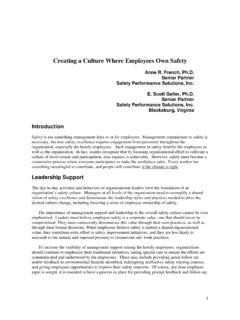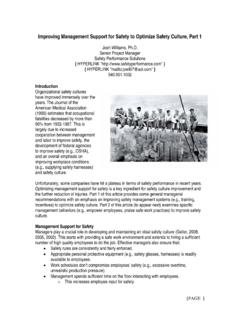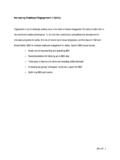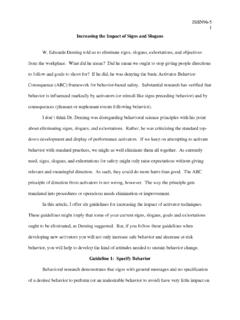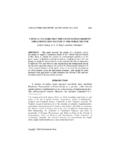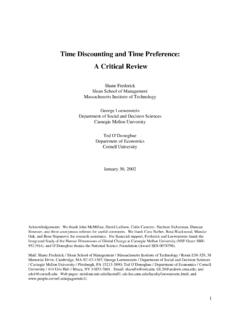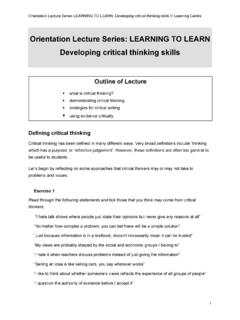Transcription of Developing A critical Behavior Checklist - Safety …
1 ISHN03-4 1 Developing A critical Behavior Checklist : Behavioral Risk The critics of Behavior -based Safety (BBS) claim injury prevention requires a holistic, system-level approach. Behavioral observation and feedback among line workers is not enough. Moreover, management must not use BBS as an excuse to shirk its responsibilities, such as Developing a more user-friendly workplace and maintaining accountability systems that keep Safety integral to daily work activities. Guess what? I agree. Actually, I ve never heard a BBS trainer or consultant disagree with the arguments used to criticize or denigrate BBS.
2 In other words, BBS reflects a philosophy and a set of tools that can be used to support any ongoing Safety initiative, especially those that are holistic, system-focused, and management-driven. A Precious Tool The basic tools of BBS can be applied to improve the behaviors of everyone involved in an organizational process, from the worker performing the hands-on activities to the supervisor overseeing the entire effort. These tools are not limited to Safety undertakings, but are pertinent to all aspects of an organization s mission statement.
3 This is the first of a two-part series on one of the most valuable BBS tools the critical Behavior Checklist (CBC). The descriptions and examples given here address Safety , but this tool is obviously applicable to everything people do in the workplace. It s vital to increasing one s competence at any task. Performance cannot improve without Behavior -based feedback, and feedback is often most informative when linked to observations recorded on a CBC. ISHN03-4 2 Simply put, the CBC consists of a list of some of the specific behaviors required to complete a task effectively.
4 There is also a column to check whether each Behavior is performed competently or incompetently. For Safety applications, this column distinguishes between safe and at-risk. The definitions of competent vs. incompetent or safe vs. at-risk are developed through structured group discussions and consensus building. The process of Developing a practical CBC that is acceptable to all potential users is invaluable. If done right, it instills a sense of team ownership, as well as self-efficacy and personal control.
5 These positive person states increase when everyone agrees to use the CBC, and these feelings are integrated into the culture whenever the CBC is used to observe coworkers and provide Behavior -based feedback. I ve discussed optimal ways to observe others and give interpersonal feedback in prior ISHN articles (see, for example, my columns for December 1993, July and August, 1996, and May, 1999). However, I have not previously addressed the challenge of selecting the behaviors for a CBC. What Are critical Safety Behaviors?
6 Obviously, the ability of an observation and feedback process to reduce injuries depends on what behaviors are included in the CBC. When you decide what Safety -related behaviors are critical for a particular application of the CBC, you define those aspects of a job which require the most attention and mindfulness for injury prevention. These are the behaviors for which people hold each other accountable to perform safely. So the development of a CBC should not be taken lightly. ISHN03-4 3 Sources that can provide information for deciding which behaviors to include on a CBC include: injury records, near-hit reports, job-hazard analyses, standard operating procedures, rules and regulations, the site s medical staff, or anyone else who maintains injury statistics for the organization, as well as the workers themselves.
7 Employees already know a lot about their own safe and at-risk work practices. They know which Safety rules they sometimes ignore, and they know when a near-hit has happened to them or to others because of at-risk Behavior . Evaluating relative risk is key to selecting the behaviors for a CBC. This boils down to deciding which behaviors create the most risk for injury. How can we determine the injury-risk of a particular Behavior ? Estimating Behavioral Risk The risk level of a particular Behavior varies along three dimensions: exposure, severity, and probability.
8 Discussing each of these dimensions with regard to a certain at-risk Behavior facilitates the process of Developing and refining a CBC. Exposure Every time an at-risk Behavior occurs, someone is exposed to potential injury. The more often this Behavior occurs and the more people performing it, the greater the exposure. For example, lifting a load greater than 40 pounds might not be very risky in one instance, but multiply this at-risk Behavior by numerous employees making several lifts per day and you gain a different perspective.
9 The duration of a Behavior also contributes to risky exposure. The longer one carries a 40-pound load, the greater the exposure. And, the longer one refrains from using personal protective equipment (PPE), the greater the exposure. Conversely, one ISHN03-4 4 brief instance of donning certain PPE, from a hard hat to a vehicle Safety belt, reduces risk exposure for the entire duration of usage. Severity Behavioral risk also varies according to the severity of possible harm or injury associated with the at-risk Behavior .
10 What s the worst imaginable scenario that could occur from a particular at-risk Behavior ? Is there potential for a fatality? Could the at-risk Behavior cause multiple deaths? Sometimes history provides hard lessons for this judgment. Certain at-risk behaviors, for example, have contributed to plant explosions, vehicle crashes, asphyxiations, and to humans crushed by equipment. These behaviors are usually included on a CBC, unless their occurrence is extremely rare, thereby making the exposure very low. Probability Behavioral risk is also influenced by the probability a Behavior will result in an injury.


